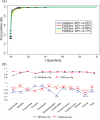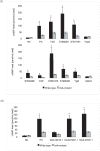Effective identification of bacterial type III secretion signals using joint element features
- PMID: 23593149
- PMCID: PMC3617162
- DOI: 10.1371/journal.pone.0059754
Effective identification of bacterial type III secretion signals using joint element features
Abstract
Type III secretion system (T3SS) plays important roles in bacteria and host cell interactions by specifically translocating type III effectors into the cytoplasm of the host cells. The N-terminal amino acid sequences of the bacterial type III effectors determine their specific secretion via type III secretion conduits. It is still unclear as to how the N-terminal sequences guide this specificity. In this work, the amino acid composition, secondary structure, and solvent accessibility in the N-termini of type III and non-type III secreted proteins were compared and contrasted. A high-efficacy mathematical model based on these joint features was developed to distinguish the type III proteins from the non-type III ones. The results indicate that secondary structure and solvent accessibility may make important contribution to the specific recognition of type III secretion signals. Analysis also showed that the joint feature of the N-terminal 6(th)-10(th) amino acids are especially important for guiding specific type III secretion. Furthermore, a genome-wide screening was performed to predict Salmonella type III secreted proteins, and 8 new candidates were experimentally validated. Interestingly, type III secretion signals were also predicted in gram-positive bacteria and yeasts. Experimental validation showed that two candidates from yeast can indeed be secreted through Salmonella type III secretion conduit. This research provides the first line of direct evidence that secondary structure and solvent accessibility contain important features for guiding specific type III secretion. The new software based on these joint features ensures a high accuracy (general cross-validation sensitivity of ∼96% at a specificity of ∼98%) in silico identification of new type III secreted proteins, which may facilitate our understanding about the specificity of type III secretion and the evolution of type III secreted proteins.
Conflict of interest statement
Figures






Similar articles
-
Computational prediction of type III secreted proteins from gram-negative bacteria.BMC Bioinformatics. 2010 Jan 18;11 Suppl 1(Suppl 1):S47. doi: 10.1186/1471-2105-11-S1-S47. BMC Bioinformatics. 2010. PMID: 20122221 Free PMC article.
-
Functional and computational analysis of amino acid patterns predictive of type III secretion system substrates in Pseudomonas syringae.PLoS One. 2012;7(4):e36038. doi: 10.1371/journal.pone.0036038. Epub 2012 Apr 27. PLoS One. 2012. PMID: 22558318 Free PMC article.
-
T3_MM: a Markov model effectively classifies bacterial type III secretion signals.PLoS One. 2013;8(3):e58173. doi: 10.1371/journal.pone.0058173. Epub 2013 Mar 5. PLoS One. 2013. PMID: 23472154 Free PMC article.
-
Mapping bacterial effector arsenals: in vivo and in silico approaches to defining the protein features dictating effector secretion by bacteria.Curr Opin Microbiol. 2020 Oct;57:13-21. doi: 10.1016/j.mib.2020.04.002. Epub 2020 Jun 5. Curr Opin Microbiol. 2020. PMID: 32505919 Review.
-
Functional domains and motifs of bacterial type III effector proteins and their roles in infection.FEMS Microbiol Rev. 2011 Nov;35(6):1100-25. doi: 10.1111/j.1574-6976.2011.00271.x. Epub 2011 May 18. FEMS Microbiol Rev. 2011. PMID: 21517912 Review.
Cited by
-
A conserved motif promotes HpaB-regulated export of type III effectors from Xanthomonas.Mol Plant Pathol. 2018 Nov;19(11):2473-2487. doi: 10.1111/mpp.12725. Epub 2018 Oct 16. Mol Plant Pathol. 2018. PMID: 30073738 Free PMC article.
-
Edwardsiella piscicida: A versatile emerging pathogen of fish.Virulence. 2019 Dec;10(1):555-567. doi: 10.1080/21505594.2019.1621648. Virulence. 2019. PMID: 31122125 Free PMC article. Review.
-
Bastion3: a two-layer ensemble predictor of type III secreted effectors.Bioinformatics. 2019 Jun 1;35(12):2017-2028. doi: 10.1093/bioinformatics/bty914. Bioinformatics. 2019. PMID: 30388198 Free PMC article.
-
Type III secretion by Yersinia pseudotuberculosis is reliant upon an authentic N-terminal YscX secretor domain.Mol Microbiol. 2022 Apr;117(4):886-906. doi: 10.1111/mmi.14880. Epub 2022 Feb 8. Mol Microbiol. 2022. PMID: 35043994 Free PMC article.
-
YscU/FlhB of Yersinia pseudotuberculosis Harbors a C-terminal Type III Secretion Signal.J Biol Chem. 2015 Oct 23;290(43):26282-91. doi: 10.1074/jbc.M114.633677. Epub 2015 Sep 3. J Biol Chem. 2015. PMID: 26338709 Free PMC article.
References
-
- Lindeberg M, Collmer A (2009) Gene ontology for type III effectors: capturing processes at the host-pathogen interface. Trend. Microbiol. 17: 304–311. - PubMed
Publication types
MeSH terms
Substances
LinkOut - more resources
Full Text Sources
Other Literature Sources

